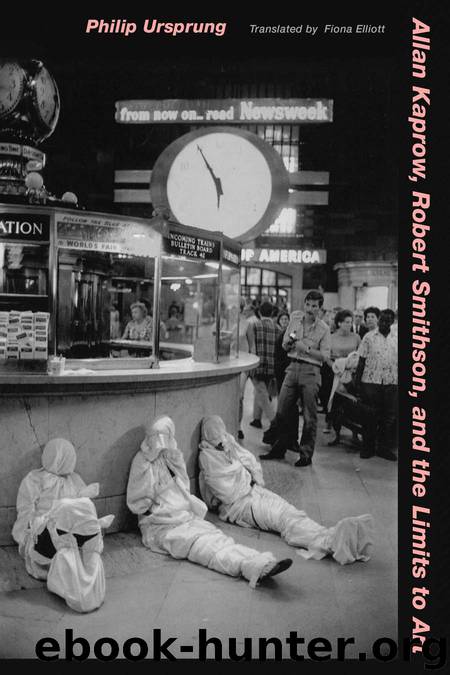Allan Kaprow, Robert Smithson, and the Limits to Art by Ursprung Philip

Author:Ursprung, Philip
Language: eng
Format: epub
ISBN: 9780520245419
Publisher: University of California Press
FIGURE 25. Robert Smithson, drawing for Wandering Earth Mounds and Gravel Paths, 1967.
While working for TAMS, Smithson invited Carl Andre, Robert Morris, and Sol LeWitt to develop related projects of their own. LeWitt already had some experience of megastructures from his time at the outset of his career in the architectural practice of I. M. Pei. Smithson presented their proposals in “Towards the Development of an Air Terminal Site” in Artforum in June 1967 and again in the essay “Aerial Art” in Studio International in 1969 (he also made a couple of sketches for an unrealized exhibition of Aerial Art).219 In the first of these essays, Smithson uses the term earth works for the first time: “The ‘boring,’ like other ‘earth works,’ is becoming more and more important to artists. Pavements, holes, trenches, mounds, heaps, paths, ditches, roads, terraces, etc., all have an esthetic potential.”220
Morris proposed Earth Mound, a circular structure with a radius of 984 feet (300 meters). Andre planned either a crater, made by dropping a ton of explosives from a height of 1.8 miles (3 kilometers), or an area planted with bluebonnets, the state flower of Texas. Andre’s first idea has an obvious connection with the American bombing of North Vietnam, which was then at its height. It also reflects the connection between airfields and the weapons industry in general. It is reasonable to assume that Andre knew of Reyner Banham’s essay “The Obsolescent Airport,” which hypothesizes that air travel was a by-product of the armaments industry and that passenger planes were nothing more than military bombers that had not made the grade.221 LeWitt, for his part, came up with an invisible intervention: a small chest with secret contents would be concealed inside a larger cube of concrete at a secret location. On 1 July 1968, in the garden of a private collector in the Netherlands, he realized a smaller version of this proposal, now titled Buried Cube Containing an Object of Importance but Little Value.
Smithson’s title “Towards the Development of an Air Terminal Site” immediately recalls the essay “Towards a Clarified Aesthetic,” written by the architectural critic Raymond Spurrier in 1962. Taking Heathrow Airport in London as his focus, Spurrier considers ways of making sense of the evergrowing disorganization at any major airport. He compares this kind of airport to an exhibition that millions of people see each day.222 In his view, architects should keep well away from the airport’s functional elements. These either speak for themselves or could, with minor interventions, be incorporated into an artistic concept. In support of this line of reasoning, he points to the aesthetic potential of a radar dish and of “permanent earthbanks, originally built also as noise deflectors.”223 His essay is illustrated with a series of photographs, titled “A Detailed Topography of the Landscape of Hysteria: London-Heathrow,” of parking lots, works of art, advertising, traffic signs, and plantings. These snapshots—mostly square like Smithson’s later Instamatic photos—have ironic-sounding captions. It is perfectly possible that Spurrier’s essay influenced Smithson’s style of
Download
This site does not store any files on its server. We only index and link to content provided by other sites. Please contact the content providers to delete copyright contents if any and email us, we'll remove relevant links or contents immediately.
The Secret History by Donna Tartt(18166)
Red Sparrow by Jason Matthews(5198)
Harry Potter 02 & The Chamber Of Secrets (Illustrated) by J.K. Rowling(3556)
In a Sunburned Country by Bill Bryson(3369)
Drawing Cutting Edge Anatomy by Christopher Hart(3290)
Figure Drawing for Artists by Steve Huston(3272)
The Daily Stoic by Holiday Ryan & Hanselman Stephen(3110)
Harry Potter and the Prisoner of Azkaban (Book 3) by J. K. Rowling(3110)
Japanese Design by Patricia J. Graham(3002)
The Roots of Romanticism (Second Edition) by Berlin Isaiah Hardy Henry Gray John(2820)
Make Comics Like the Pros by Greg Pak(2758)
Stacked Decks by The Rotenberg Collection(2687)
Harry Potter and the Deathly Hallows (7) by J.K. Rowling(2550)
Draw-A-Saurus by James Silvani(2504)
Tattoo Art by Doralba Picerno(2488)
On Photography by Susan Sontag(2485)
Foreign Devils on the Silk Road: The Search for the Lost Treasures of Central Asia by Peter Hopkirk(2388)
Churchill by Paul Johnson(2364)
The Daily Stoic by Ryan Holiday & Stephen Hanselman(2344)
